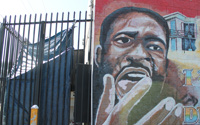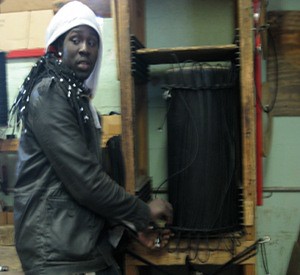Drums of Africa
These are just some of the 200 different types of drums crafted and sold at Motherland Music.
From its incorporation in 1850 to the riots in 1992, Los Angeles is a city full of rich history. But in South LA, an area that has faced neglect by the media, much may not be documented about the area’s eventful past. Word-of-mouth is one of the only methods of preserving history in the community. This story tells the history of the area south of Slauson through five community members.
The question where to park a car isn’t necessarily something traffic goers think about. Maybe they park it on a street corner, or in front of the store or in a small parking lot. They park, largely, wherever it is convenient. But in South Los Angeles, that is also a problem, as evidenced by a number of car jackings and various other accounts of automobile theft, according to officials. There are possible explanation for this. Lack security? Lack of public parking? All paint a world where parking a car isn’t always safe.
People Helping People is a non-profit organization that has been helping the homeless community in South Central for 16 years. In January, the city of Los Angeles cut the funding previously given to People Helping People, which forces the organization to shut down in the next two months. My project focuses on the organization and its struggles. The audiovisual slideshow portrays one of the long-term clients on People Helping People.
By Sarah Webb
Collecting members from California, Texas and even Mexico, Mariachi Bandido is a local mariachi band that plays at birthdays, weddings, anniversaries and more throughout the heart of South Central Los Angeles. Each member has a different story to tell: an explanation for how they began playing the upbeat, syncopated rhythms mariachi is so famous for. Whether they were born into it, were forced to do it or just decided to try it out, their decisions changed their lives forever. This music from across the border is rich in culture and history, and the members of Mariachi Bandido are living proof.
Leo Garcia, a Mexico native, was born into a world centered on mariachi music. “I started to play mariachi because I love my roots,” he said, “I try to follow the steps of Mexican culture, such as the mariachi.” A simpler version of mariachi music began in the state of Jalisco, Mexico in the 19th Century. Garcia explains that a mariachi band’s instrumental makeup was slightly different in the beginning. “The first mariachi was only strings and guitarron and vihuela…they didn’t have a trumpet.” There are as many as two trumpets in traditional mariachi bands today. Silvestre Vargas was one of the first to introduce the trumpet into the mariachi ensemble. “He decided to experiment and add the trumpet and see how it sounds.” What began as a solely string-supported band, Garcia is fascinated with how the mariachi sound transformed. “Now look at what we have now,” he said, ”We have beautiful mariachis.”
Trumpet player and Texas native Arnoldo “Arnie” Barrera began playing mariachi well into his musical career. “I had been playing a lot of big band, tex mex, a little country,” he said. He played it initially to help out a friend and fellow musician. “So one day, about maybe eight years ago, a friend of mine asked me to help him out,” he said. Only after agreeing did Barrera discover that he would be playing mariachi. “I told him that I knew nothing about mariachi music,” he said. The mariachi style has stuck with him ever since. “I’d rather play mariachi music than go out there with my band now,” he said, “because it’s so much fun.” What Barrera enjoys most is the personal connection mariachi fosters between the performers and the audience. “You get close to the people. They join in, sing with you and you make them happy.”
Rebecca Gonzales gave mariachi music a shot at an impromptu visit to a college course at San Jose City College. A music professor approached her at random and encouraged her to try it out. “I think he came up to me because I look Latin,” said Gonzales. Before then, Gonzales had never even heard of mariachi. “He said, ‘Would you like to come to my mariachi class?’ and I said. ‘What’s mariachi’? That’s how out of it I was.” Gonzales remembers growing up with a different style of music thanks to her Texan parents. “They used to play norteño music, which is from the northern part of Mexico.” Norteño is a different genre of Mexican music characterized by its heavy use of the accordion and bajo sexto, which is essentially a guitar with 12 strings. However, something struck her as odd about the professor’s offer, and piqued her curiosity. “He was a ‘gringo’, a non-Latin, and it got my attention,” she said, “and I said ‘Wait a minute, if this guy likes it, I should at least go check it out.’” She took to it immediately, and she credits this class as her jumping-off-point. “I remember that night going to my father and saying, ‘Dad, this is what I want to do the rest of my life.’ It was just like that…I fell in love with it.”
Guitarron player and leader of Mariachi Bandido, Fred Herrera has a long musical family past. His father, a professional musician from Mexico, found success in the United States in the television industry. Starting as a touring musician in the 1930s and 1940s, he began playing in popular television shows soon after he arrived. “He played with Desi Arnaz, and he was a piano player on the ‘I Love Lucy’ shows.” Despite his father’s strong background in Latin music, Herrera came of age in a different musical era: one centered on the new, wildly popular rock n’ roll. Consequently, his first band he formed, Sweetwater, mixed the sounds of folk, jazz and rock. The band was the first to play in the historic 1969 Woodstock Music Festival. Herrera began playing gigs with his father, “you know, one-nighter jobs, before he passed away.” Soon after, his father’s former contemporaries began hiring Herrera to play events for them, despite him having little experience actually playing mariachi. “I started learning the music,” he said, “and I just grew into it because I love it…” Of all the musical subgenres he has had a taste of, there is something special about mariachi that keeps him coming back: its universality. “You know, every place you play it, people just absolutely love it, no matter who the audience is,” he said. “That is what intrigues me.
Joseph Bruley met Herrera in 1972 when they both played in the rhythms section of rock and folk singer, songwriter Chi Coltrane’s album, and has been collaborating with him ever since, including on Sweetwater. It wasn’t until 1980 that Bruley began playing mariachi. “Fred got into playing guitarron for a show called the Ramona Pageant that’s been going on since the 20’s,” Bruley said. The Ramona Pageant is the longest running outdoor play in the United States and occurs annually in Hemet, California. The pageant introduced Bruley to the Latin-style sound. “That sort of led us into mariachi,” Bruley said, “and so here we are.”
Mariachi Bandido plays for events of every type up and down the streets of South Central Los Angeles. They are famously known for their brief appearance in the film “The Heartbreak Kid” starring Ben Stiller, where they portray an intrusive, loud and obnoxious mariachi band providing dinner entertainment. A short clip of their performance can be viewed here.





